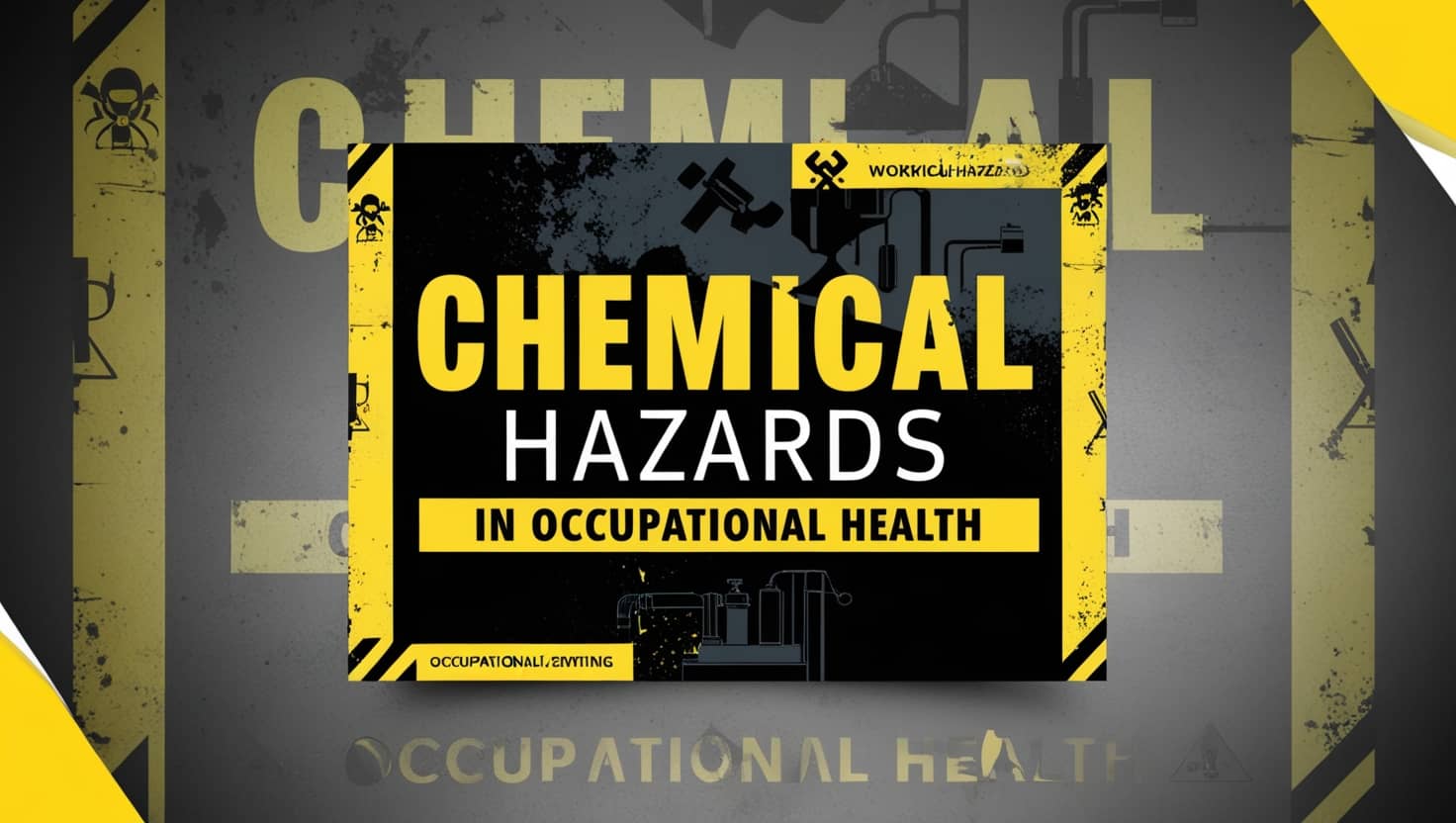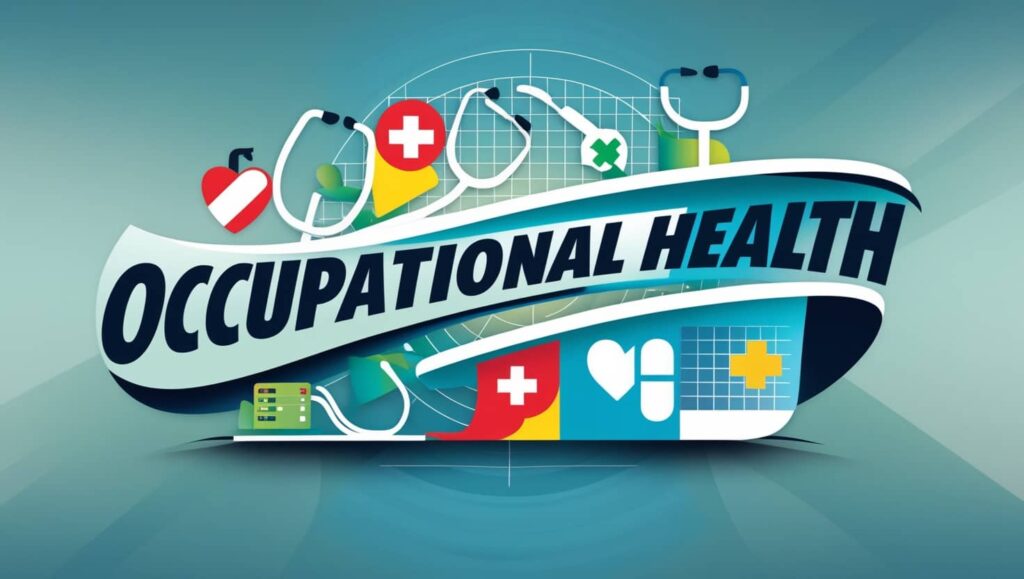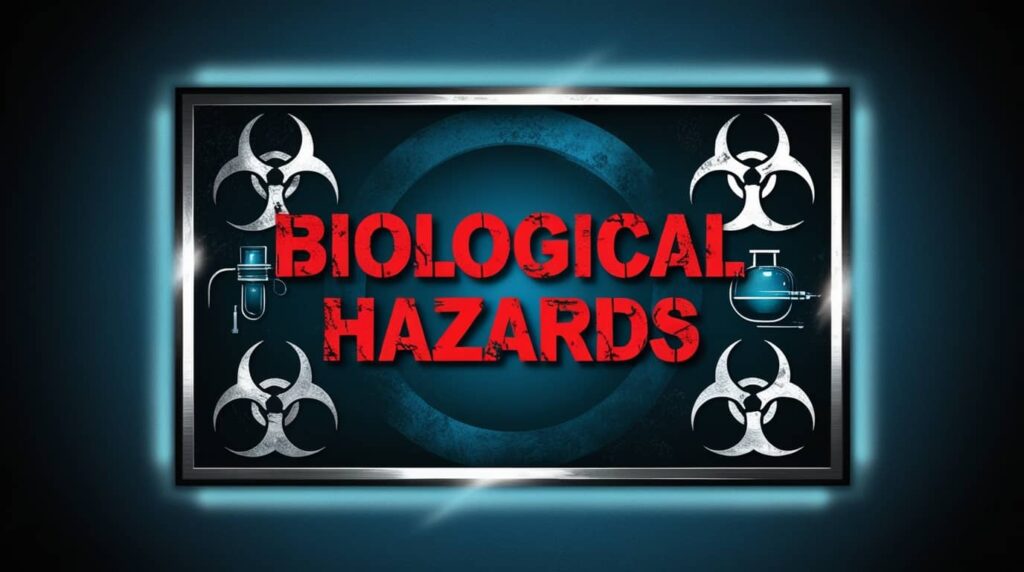Chemical hazards are a significant occupational health and safety concern in the workplace.
Hazardous chemicals include industrial chemicals, pesticides, agricultural chemicals, pharmaceuticals, cosmetics, and food-related chemicals that may be present in the workplace.
They may harm a worker’s health as a result of direct contact with or exposure to the chemical.
Chemicals can exist in the form of:
- Solids such as dust, fumes, and fibers (e.g., bitumen fumes wood dust, and asbestos fiber).
- Liquids, mists (e.g., liquid bleach and mineral oil mist).
- Gases, vapors (e.g., carbon monoxide gas and solvent vapors).
Types of Chemical Hazards
Chemical hazards are categorized as follows by workplace hazardous materials information: –
1. Class A
- Compressed gas.
- Dissolved gas or liquefied gas.
2. Class B
- Flammable gases.
- Flammable and combustible liquids.
- Flammable solid.
- Flammable aerosols.
- Reactive flammable material.
3. Class C
- Oxidizing materials – oxidizer and an organic peroxide.
- Oxidizer: Chlorates, nitric oxide, peroxides, permanganates, perchlorates, nitrites, nitrates, and easily oxidize metal powder.
- Organic peroxide: Tetra hydro furan, diethyl ether, dioxane, and methyl isobutyl ether.
4. Class D
- Poisonous and infectious materials such as cyanides, tea salts, and asbestos.
5. Class E
- Corrosive materials such as inorganic acids and bases, and hydrogen fluoride.
6. Class F
- Dangerous reactive materials such as ethylene dioxide, organic azides, Na, Li, and Ca.
7. Pyrophosphoric materials such as white phosphorous, diethyl aluminum chloride, and lithium.
8. Carcinogens.
9. Sensitizing and Reprotoxic Substances.
10. Mutagenic.
Read Also: Types of Hazards in Occupational Health
List of Chemical Hazards
1. Particles, fibers, fumes, and mists
- Coal dust.
- Cotton dust.
- Flour dust.
- Grain dust.
- Wood dust.
- Crystalline silica (quartz).
- Asbestos.
- Machine-made mineral fiber.
- Diesel engine exhaust emissions.
- Rubber process dust/fume.
- Rosin-based solder flux fume.
- Welding fume.
- Oil mist.
2. Metals and metalloids
- Aluminum.
- Arsenic.
- Beryllium.
- Cadmium.
- Chromium.
- Cobalt.
- Copper.
- Iron.
- Lead.
- Manganese.
- Mercury.
- Nickel.
- Vanadium.
- Zinc.
3. Organic solvents and compounds
- Acetone.
- Acid anhydrides (cyclic anhydrides).
- Acrylamide.
- Acrylonitrile.
- Benzene.
- Carbon disulfide.
- Chloroform.
- Dichloro-4, 4-methylene dianiline.
- Formaldehyde.
- Glutaraldehyde.
- Isocyanates.
- Methyl ethyl ketone.
- n-Hexane.
- Pesticides.
- Phenol.
- Styrene.
- Tetrachloroethylene (Perchloroethylene).
- Vinyl chloride.
4. Inorganic gases
- Arsine.
- Carbon monoxide.
- Hydrogen sulfide.
- Nitrogen dioxide.
- Ozone.
- Sulfur dioxide.
Read Also: Biological Hazards | Types, Sources, and Risk Control
Routes of Exposure to Chemical Hazards
Inhalation → Breathing in contaminated air is the most common way for workplace chemicals to enter the body.
Skin contact → Some chemicals, by direct or indirect contact, have the potential to damage the skin or pass through the skin into the bloodstream.
Ingestion → If food or hands are contaminated at the workplace, chemicals may be accidentally swallowed.
Injection → It can occur when a needle or other sharp object punctures the skin and injects a chemical directly into the bloodstream.
The eyes might also serve as a route of entry. In the workplace, only very small amounts of chemicals enter through the mouth or eyes.
Effects of Chemical Hazards
Acute effects are those that appear immediately after a chemical exposure occurs.
For example, a chemical burn will occur immediately if acid is spilled on the skin.
Chronic effects are those that appear after a significant period of time passes and are usually caused by multiple exposures over a period of time.
Cancer is a common example of a chronic effect because cancers caused by chemical exposures often do not show up until twenty or more years after the initial exposure.
Some common examples of the effects of hazardous chemicals include:
- Skin irritation, dermatitis, or skin cancer from frequent contact with oils.
- Injuries to the hands and eyes caused by contact with corrosive liquids.
- Asthma is caused by sensitization to isocyanates found in paints and adhesives.
- Long-term disability due to lung diseases caused by dusty environments (e.g., exposure to respirable crystalline silicate).
- Death or injury caused by toxic fume exposure (e.g., carbon monoxide).
- Cancer causes death many years after first being exposed to carcinogens at work (e.g., asbestos).
“Many chemicals can cause severe burns when they come into contact with living tissue.”
Living tissue may be destroyed by the following chemical reactions:
- Dehydration by strong dehydrating agents.
- Digestion by strong acids and bases.
- Oxidation by strong oxidizing agent.
Chemical hazards are toxic, corrosive, irritant, carcinogenic, flammable, and mutagenic.
Carcinogen → A chemical that causes or has the potential to cause cancer (e.g., asbestos, formaldehyde).
Corrosive → A chemical that causes visible destruction of, or irreversible alterations in, living tissue by chemical action at the site of contact (e.g., hydrochloric acid).
Irritant → A non-corrosive chemical that causes reversible inflammatory effects on living tissue at the site of contact (e.g., strong solvents).
Mutagen → A chemical that causes chromosome damage (e.g., benzene).
Sensitizer → A chemical that causes an allergic reaction in a large number of people who are exposed to it (e.g., isocyanates)
Teratogen → A chemical that causes birth defects (e.g., thalidomide).
Safety Measures for Chemical Hazards
A “chemical hazard pocket guide” should be consulted before starting work with a chemical to obtain the necessary knowledge about the chemical.
It provides information on the potential reactions the chemical may produce as well as its inflammability, carcinogenicity, methods for prevention and treatment, etc.
- There should be no eating, drinking, or smoking in areas where chemicals are used.
- Protective clothing should be worn to cover exposed skin.
- As soon as clothing becomes wet or chemically contaminated, it should be removed.
- Eyes or skins should be washed with plenty of water after an accident.
- Face masks can be used when exposed to toxic dust or gases.
- Workers who work with antibiotic-related products must be changed on a regularly so that an individual is not exposed to a specific antibiotic for an extended period.
- When a worker develops a dust allergy or a respiratory problem, he or she should be removed from the workplace and placed under proper medical care.
- When flammable gas or solvent leaks, exhaust fans should be started and all fire sources should be extinguished.
Related: Physical Hazards in Occupational Health
Control Measures for Chemical Hazards
- Elimination
The most reliable and efficient controls are those that lead to the elimination of hazardous chemicals.
- Substitution
The next control of choice is the substitution of a hazardous chemical for a less hazardous one, but care must be taken to ensure that the substituted chemical does not introduce new hazards.
Substitution may also involve using the chemical in a less hazardous form or process (e.g., the use of a chemical in a pellet form rather than dust).
- Isolation
An efficient method of control is to isolate the chemical from persons who might be exposed in time or space.
For example, placing people in a secure control room, installing a buffer area around a chemical reactor, and using the material when people are not in the vicinity.
- Engineering controls
Engineering controls often decrease exposure at the source (e.g., by enclosing the process in vessels or pipes, or by local exhaust ventilation).
It’s crucial to prevent uncontrolled releases; this can be achieved by using strategies including quantity reduction, segregation, secure storage, and temperature control.
- Administrative controls
Administrative controls are generally required to supplement higher-level controls.
Administrative controls may include equipment maintenance and training for employees and their managers in the operation of the equipment.
Preventative maintenance is essential for avoiding uncontrolled releases.
Work procedures may need to be developed to ensure that engineering controls function as intended; this includes any safe-handling procedures and special storage instructions.
- Personal protective equipment
Employees may be required to wear PPE to lessen exposure to chemicals that are inhaled or come into contact with their skin or eyes.
It might be necessary to have specialized knowledge to choose the right PPE for a specific chemical.
To protect against chemicals absorbed through the skin, gloves must be selected using chemical resistance charts or databases, as well as taking into account the potential for chemical permeation, penetration, and degradation of the PPE.
Summary
Chemical hazards are a significant occupational health and safety concern in the workplace.
Hazardous chemicals include industrial chemicals, pesticides, agricultural chemicals, pharmaceuticals, cosmetics, and food-related chemicals that may be present in the workplace.
Chemical hazards include: –
- Particles, fibers, fumes, and mists such as coal dust, cotton dust, and asbestos.
- Metals and metalloids such as lead, mercury, and arsenic.
- Organic solvents and compounds such as acetone, acid anhydrides, benzene, chloroform, and pesticides.
- Inorganic gases such as carbon monoxide, hydrogen sulfide, and sulfur dioxide.
Chemical hazards can enter the human body through inhalation, skin contact, ingestion, and injection.
They have acute and chronic effects.
Acute effects are those that appear immediately after a chemical exposure occurs.
Chronic effects are those that appear after a significant period of time passes and are usually caused by multiple exposures over a period of time.
Chemical hazards can cause: –
- Skin irritation, dermatitis, or skin cancer from frequent contact with oils.
- Injuries to the hands and eyes caused by contact with corrosive liquids.
- Asthma is caused by sensitization to isocyanates found in paints and adhesives.
- Long-term disability due to lung diseases caused by dusty environments (e.g., exposure to respirable crystalline silicate).
- Death or injury caused by toxic fume exposure (e.g., carbon monoxide).
- Cancer causes death many years after first being exposed to carcinogens at work (e.g., asbestos).
Chemical hazard controls include elimination, substitution, isolation, engineering controls, administrative controls, and personal protective equipment.
References
- Chemical hazards and safety management in pharmaceutical industry. Retrieved December 25, 2022, from ResearchGate
- Chemicals. from Health and Safety Authority
- Sadhra, S. S., Bray, A., & Boorman, S. (2022). Oxford Handbook of Occupational Health. Oxford University Press.
- 17 chemical hazards – ohsbok.org.au. (n.d.). Retrieved December 25, 2022, from OHS Body of Knowledge
Yusuf Saeed
Pharmacist | Medical Writer & Translator
Yusuf Saeed graduated from the Arab Academy for Science and Technology and Maritime Transport with a B.Sc. in Pharmaceutical Sciences. His passion for research and healthcare communication led him to specialize in medical writing and translation. Yusuf is committed to delivering accurate, well-researched content that empowers readers with reliable medical information and bridges language gaps in healthcare education.
As the founder of Medserene, Yusuf Saeed established the platform with a vision to provide trustworthy medical content and accessible healthcare information. His mission is to create a reliable resource that empowers readers to make informed decisions about their health and well-being. Driven by his passion for clear communication and healthcare education, Yusuf aims to bridge the gap between medical knowledge and everyday understanding.







